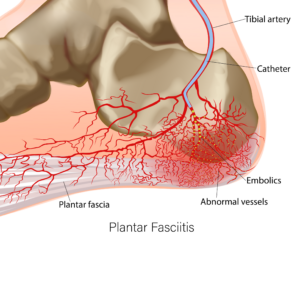Non-Surgical Plantar Fasciitis Treatment in Kansas City | Embolization Specialists
Discover the Benefits of Plantar Fasciitis Embolization (PFE) at Restore Muscle and Joint
Plantar fasciitis is one of the most common causes of heel pain. When conservative measures like rest, ice, stretching and orthotics aren’t enough, a minimally invasive procedure called plantar fasciitis embolization can provide lasting relief. In chronic cases, abnormal blood vessels form around the inflamed plantar fascia; embolization targets these vessels to reduce inflammation and pain.
What Is Plantar Fasciitis Embolization?
PFE is performed by a board‑certified interventional radiologist. Using imaging guidance, a thin catheter is inserted through a small puncture in the ankle or thigh and navigated to the tiny arteries feeding the inflamed plantar fascia. Tiny microparticles are injected to block these abnormal vessels, allowing the tissue to heal naturally. The procedure typically takes 30–60 minutes and is done on an outpatient basis, so you go home the same day.

Key Steps
- Catheter insertion: A small catheter is placed into a blood vessel in the ankle or thigh.
- Guided navigation: Imaging (ultrasound or X‑ray) guides the catheter to the abnormal blood vessels supplying the plantar fascia.
- Particle injection: Biodegradable particles are injected to block the blood flow, reducing inflammation and pain.
Benefits of PFE
- Minimally invasive: No surgical incision means less trauma, minimal scarring, and a lower risk of infection.
- Quick recovery: Most patients resume normal activities within days after the procedure.
- High success rates: Studies report significant reductions in heel pain; one study noted that 80% of patients experienced substantial relief after embolization.
- Outpatient procedure: The treatment is performed under local anesthesia with light sedation, and patients go home the same day.
- Avoids steroids and implants: PFE treats the source of pain without long‑term steroid use or implants, reducing the risk of plantar fascia rupture.
Who Should Consider PFE?
You may be a candidate if you have chronic plantar fasciitis that has not improved with conservative therapies such as rest, physical therapy, NSAIDs or orthotics. Patients who cannot wait 6‑12 months for symptoms to resolve naturally may also benefit. Our healthcare team will evaluate your medical history and imaging studies to determine whether PFE is appropriate.
Safety and Considerations
Plantar fasciitis embolization has an excellent safety profile when performed by experienced interventional radiologists. However, individual results vary. As with any procedure, there are potential risks such as bruising, mild numbness or non‑target embolization; these are rare when the procedure is performed correctly. We’ll discuss your medical history, current medications and any allergies before scheduling your procedure.
Frequently Asked Questions About Plantar Fasciitis Embolization in Kansas City
1. What is Plantar Fasciitis Embolization?
Plantar Fasciitis Embolization (PFE) is a minimally invasive procedure that reduces chronic heel pain by blocking tiny abnormal blood vessels that cause inflammation around the plantar fascia. It’s performed through a small pinhole in the wrist or groin, with no incision or stitches required.
2. How does Plantar Fasciitis Embolization work?
Using advanced imaging, a vascular specialist inserts a micro-catheter into the arteries supplying the inflamed fascia. Microscopic particles are injected to reduce abnormal blood flow, lowering inflammation and pain while promoting natural healing.
3. Who is a good candidate for this procedure?
You may qualify if you:
-
Have suffered from heel pain for 6 months or longer
-
Have failed conservative treatments like orthotics, injections, or physical therapy
-
Have confirmed plantar fasciitis on imaging
-
Want a non-surgical alternative with minimal downtime
Restore Muscle and Joint offers a free consultation to determine if you qualify.
4. How effective is Plantar Fasciitis Embolization?
Studies show over 70-80% of patients experience significant pain relief within weeks, with continued improvement over time. Many patients return to normal walking and activity levels without surgery or long recovery periods.
5. Is Plantar Fasciitis Embolization covered by insurance?
In most cases, yes. Medicare and many major insurance plans may cover the procedure when medical necessity is established. Our team offers a complimentary insurance benefit check before scheduling.
6. What is the recovery like?
Most patients walk the same day and return to normal activities within a few days. There are no surgical incisions or sutures, and post-procedure pain is usually mild compared to traditional surgery.
7. How does this compare to plantar fasciotomy or heel surgery?
Unlike surgery, PFE:
-
Requires no cutting or anesthesia
-
Has minimal recovery time
-
Carries lower risk of infection or complications
-
Can be performed in-office in as little as an hour
8. What are the risks or side effects?
Complications are rare but may include temporary bruising or mild soreness at the catheter site. Because this is a minimally invasive, image-guided procedure, risks are significantly lower than open surgery.
9. Who performs the procedure at Restore Muscle and Joint?
PFE is performed by our vascular surgeons, both specialists in advanced endovascular procedures.
10. How can I schedule a consultation in Kansas City?
You can schedule by calling (816) 452-4488 or visiting 4119 NW Barry Rd., Kansas City, MO 64154. We also offer same-day appointments and free imaging reviews to determine candidacy.
Schedule a Consultation
If heel pain is limiting your daily life, you don’t have to suffer. Our team at Restore Muscle and Joint and Restore Vascular & Vein Center specializes in innovative treatments like plantar fasciitis embolization. Contact us to schedule a consultation and find out whether this minimally invasive procedure is right for you. We’ll review your case, answer your questions and help you take the next step toward long‑lasting relief.
